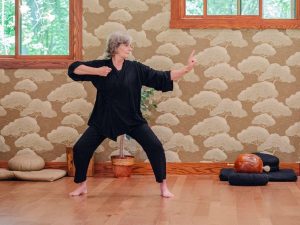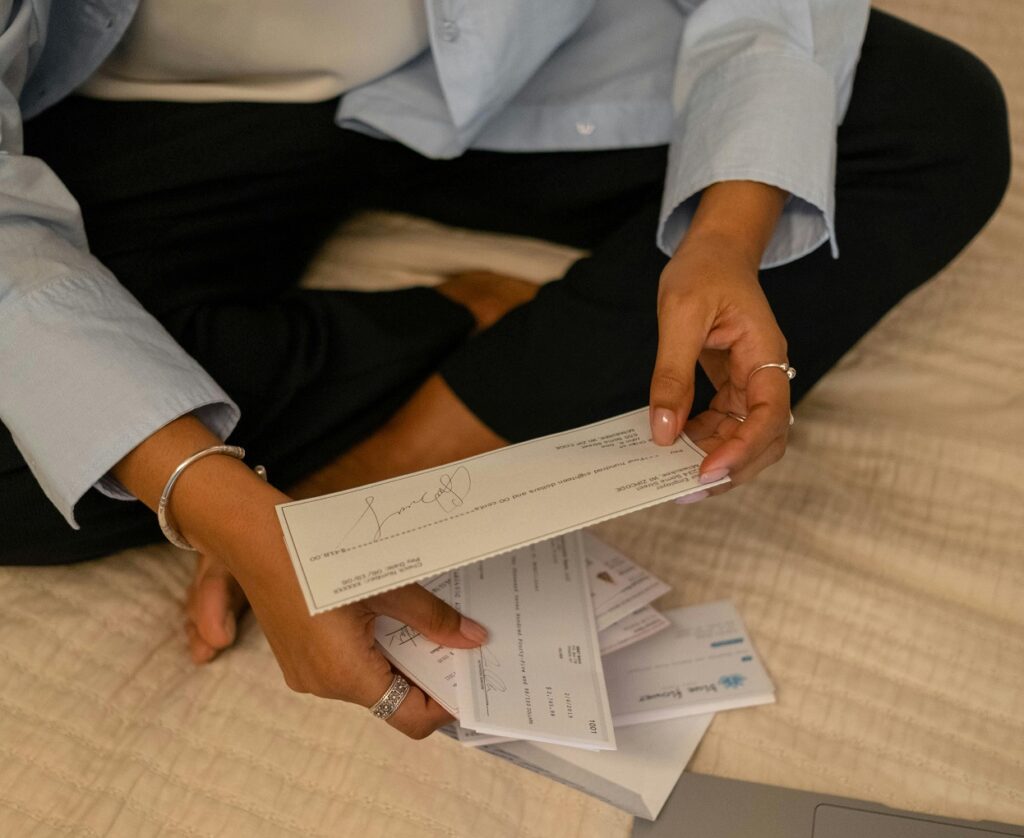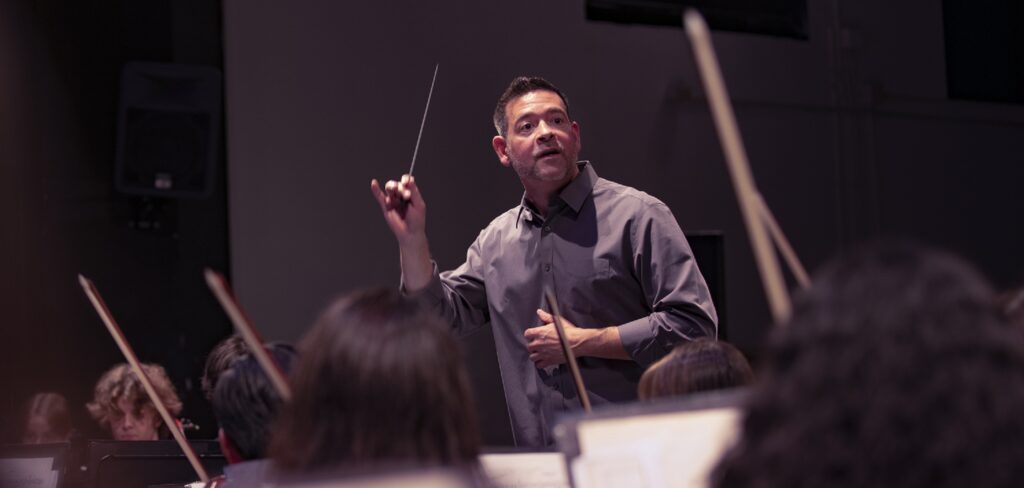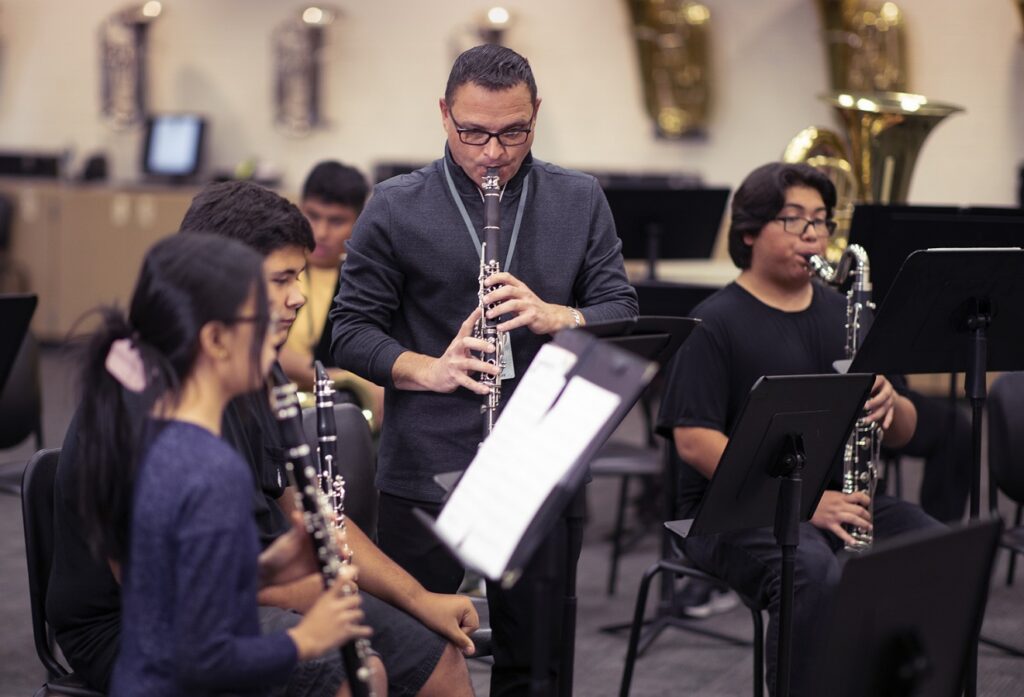Zen, Qi Gong and Music
During the pandemic, an initiation into the Zen Buddhist community changed a music educator’s perspective of music-making and teaching.
I would like to thank Reverend Rinsen and Reverend Do’on (pictured above with me) as well as Reverend Shokai for helping me through my jukai journey. I also want to give a big shout out to talented photographer Luna (Shōsō) Kasior Bitner for doing a last-minute photoshoot. I could not have written this article without all of you!
Last spring, in the midst of the pandemic, we began the process of jukai, an initiation into the Zen Buddhist community. “Ju” translates to granting, and “kai” means precepts. Jukai is the process of undergoing an empowerment ceremony in which one takes the three refuges, three pure precepts and the 10 grave precepts. Zen practitioners spend weeks writing their own personal interpretations of these precepts, such as vowing not to kill — whether it be animals or the energy of a room. Then we sew a miniature Buddha robe; the material representation of the vows we take, in each handmade stitch.
So what does this have to do with music and teaching music?
For me, the answer is … everything.
The process of undertaking jukai changed the way I relate to my instrument, the flute, as well as how I teach it to others. Before, my flute playing felt academic and distanced. Now, my experience is more emotive and natural. The flute isn’t something to be studied and polished, but rather, a paint brush for musical expression.
Meditating Altered my Teaching Style

Science has made a lot of headway in mindfulness research since the early 2000s. A 2003 study by Joanne C. Chang, Elizabeth Midlarsky and Peter Lin found that mediation reduced performance anxiety in musicians. According to the study, 66% of musicians and college music students experience anxiety. It’s likely that music teachers experience similar levels of anxiety, so any tools we can use to combat tension will help us grow as educators and creatives.
Shortly after I received Jukai, I noticed that my teaching style changed for the better. Just one week of sewing and sitting zazen (meditating), as well as participating in mindful cleaning, walking and cooking caused a major shift in my perspective. I wasn’t in a rush for my students to get things right on the first try, and I no longer tried to explain lessons to them correctly as fast as possible. It seemed like the world was full of time: There was a universe in every breath. I had the chance to really think about what I was about to say.
One of the workshops that impacted how I relate to music and music performance was qi gong.
Qi Gong: A Body Practice
Qi gong (pronounced chi gong) is a body practice and martial art that developed in China roughly 5,000 years ago. According to Piedmont.org, the difference between qi gong and tai chi is that qi gong’s body positions are used for specific situations, whereas tai chi aims to create a seamless flow between movements.
During the retreat, I experienced qi gong in sessions led by Rev. Shokai. While barefoot, we had body practice outside on the grass in front of the temple, which was a grounding break for all of us after a long day of sesshin (a period of intensive mediation practice from dawn until dusk).
“In both Zen and qi gong, we are practicing embodiment.
We work with the mind, energy and body, realizing that they are not separate
and this has a profound impact on the way we live our lives.” — Rev. Shokai
When practicing qi gong, I could clearly feel the energies in my body. Similar to sitting meditation, I was aware of every tiny muscle and pang of pain, especially from my asthma. I couldn’t avoid the tensions in my body or the intrusive thoughts that didn’t serve me. Body practice and meditation make you confront your problems head on, instead of being distracted.
Despite being painfully aware of everything happening inside my body and mind, I felt uplifted and refreshed after each afternoon session. All discomfort seemed to dissolve into the cool earth.
Teaching and Playing Music After the Retreat
I didn’t notice how profoundly my week-long retreat affected my career as a music teacher and performer until I returned home.
I greeted my distance flute students on Zoom and noticed how seamlessly our conversations flowed. After spending days in silence, I was better able to connect with my students. Since my own anxiety was lessened, I was better able to think about my private students, and what they wanted to achieve creatively. My students laughed more and learned more.
My descriptions of playing the flute and achieving certain embouchures were no longer broad strokes but became extremely specific descriptions of how I found each timbre and tone color.
Before, I gave specific and dry examples of how to play the instrument, such as “Tighten your corners” or “Shoot for a direct tone and bring up the volume.” This type of teaching is necessary in private lessons, but now my instructions are infused with more creativity and emotions. I now ask, “How would you make this section sound more pointed?” or “What can you do to make the piece sound more oceanic and flowing?”
I now offer guidance with more questions, which makes students feel more involved in the learning process. I allow myself to think outside the box, and even encourage students to imagine their own character arcs for each piece or movement.
Religion or Metaphor?

If all of this sounds a little woo-woo, you’re not alone. You don’t even have to take my word for it. Many members of our jukai class of 2021 do not believe in the heavens or any of the religious concepts. Some practitioners think of these ideas as metaphors or concepts that further aid our practice and help us delve into deeper relaxation and awareness.
Meditation and Mindfulness in the Classroom
Formal Zen training isn’t for everyone, but I believe there is a lot to take away from this.
I’m not saying that you should ask your students to meditate in class. Depending on your circumstances, this could actually be the opposite of Zen. I remember back in high school when we studied ancient religions, and our history teacher had our class meditate for five minutes each day for one week. Unfortunately, the result was out-of-control classroom.
Not every student wants to participate in or is interested in meditation. But in the process of receiving jukai, I learned that as music teachers, we can meditate for our students.
By raising up your own energy and feeling calm and centered within your own body will affect the people around you — especially young people — in a very palpable way. Meditation requires a certain level of maturity, so gauge where your students are at before imposing a mandatory five-minute sit before every class period
Zen is Music
While Zen practitioners are known for taking vows of silence, we aren’t quiet all the time. Being quiet is a practice … but so is making noise! You will hear many instruments, such as chimes, bells and even rumbling drums, in the zendo, or meditation hall.
I think of Zen as silence with music in between the cracks.
Show your students examples of Zen practice, particularly Zen music, which may help cultivate some gravity with your students about how much every seemingly small noise matters. Consider showing your students this video, which features some of the musical instruments of Zen liturgy.
That being said, it’s difficult to convey the depth of feeling that rises as one merges with the practice, the people and the full experience of the zendo in mere words and videography.
The more you and your students are aware of your emotions and body will help you become one with your musical process. So, go forth! Or rather, find a buckwheat cushion!
More About the Buddhist Temple of Toledo
This article was inspired by my experiences at the Buddhist Temple of Toledo, which is a Soto Zen temple, and with Professor and Rev. Jay Rinsen Weik, as well as all the helping hands and members of the jukai class of 2021.
Photos by Luna (Shōsō) Kasior Bitner
















